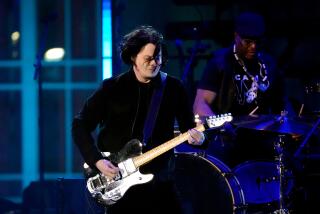Extra Demands on Cash-Strapped L.A. Festival : Money: Working with a restricted budget, the festival must accommodate non-traditional artists’ unusual needs.
- Share via
For 11 performances of the Hindu epic “Mahabharata” during the 1987 Los Angeles Festival, Tom Larson says he spent $3.25 million to create the elaborate staging of the production.
For Los Angeles Festival 1990, Larson has a budget of only $800,000--to create 30 different stages at some 40 different locations throughout Los Angeles County for more than 136 programs in the curated portion of the festival.
Add in the more than 400 venues for more than 600 attractions in the Open Festival, 300 of which are free, and Larson, production director for next month’s 17-day celebration of Asian, Latin and Pacific arts, has a challenge ahead of him.
The $800,000 must cover not only staging expenses, but also the costs of providing security, insurance, health permits, parking, water, electricity and toilets at all locations.
“In past festivals, they’ve had millions to use,” Larson said. “The budget I had on ‘Mahabharata’ would have produced this whole festival. And that was just one show that was performed 11 times. It’s kind of sad to see that much money go down for one thing.”
With a total budget of $5 million--and $200,000 of that still to be raised--the financially strapped 1990 Festival is cutting corners.
In order to arrive within budget, Larson plans to rely on more volunteer staff after festival officials asked him to pare down his budget substantially below the $800,000 allocation. It became impossible, he said.
Unlike the festival of 1987 and its predecessor, 1984’s Olympic Arts Festival, which consisted mostly of ticketed performances, 75% of this year’s programs are free of charge.
European theater and dance companies generally required traditional wood-floor stages. “For this, you almost have to reinvent the (staging) process in order to do it,” he said.
And while a majority of performers in the two previous festivals were from Europe, many of this year’s performers require money for air fare from remote areas of the Pacific and Far East. Fund-raising efforts for this year’s non-traditional arts events have also yielded fewer dollars than the Eurocentric festivals of previous years.
Some artists are not “performers” in the traditional sense, either, Larson added. Many will present religious or sacred rituals with special requirements of their own.
Dancers from the Pacific and Asia also have special requirements, Larson said. Rather than wood floors like ballet and modern dancers, many troupes perform barefoot on earth and grass. The Pacific Stage at Angel’s Gate will be covered with earth topped by sod. Other stages will be covered with cork to keep them from overheating in the sun and burning dancers’ feet.
Los Angeles Festival 1990 includes such staging challenges as building a pendopo , or replica of a palace courtyard, for the Court Dancers of Java at L.A. State and County Arboretum; an altar for Korean shamans near Angel’s Gate Park’s Korean bell; a circular area surrounded by arbors in the same park for an Indian powwow and circus stage for a Chilean theater company at the end of the Santa Monica Pier.
The Bread and Puppet Theater of Glover, Vt., which uses marionettes ranging from a few inches to 40 feet in height, will stage some of its performances at an empty hangar at the Santa Monica Airport. For its Griffith Park performances, a brick kiln must be built for baking bread to be distributed to the audience.
The Indian powwow posed particular problems, because the Indians also wanted a space to camp nearby rather than lodge at the UCLA Artists Village with most of the performers.
“There were major problems finding them somewhere to camp, because there are no campgrounds in that area,” Larson said. “We have since found an ancient Indian campground nearby.”
More to Read
The biggest entertainment stories
Get our big stories about Hollywood, film, television, music, arts, culture and more right in your inbox as soon as they publish.
You may occasionally receive promotional content from the Los Angeles Times.










